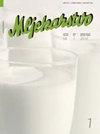杂交和LPL基因型对羊奶产量、成分和品质的影响
IF 1.1
4区 农林科学
Q3 AGRICULTURE, DAIRY & ANIMAL SCIENCE
引用次数: 1
摘要
本试验旨在探讨杂交和LPL基因型对羊奶产量、组成和品质指标的影响。本研究在立陶宛的一群纯种萨宁山羊、盎格鲁-努比亚山羊以及萨宁山羊和盎格鲁-努比亚山羊的杂交山羊(n=137)中进行。萨宁×盎格鲁-努比亚杂交山羊和萨宁的产奶量分别显著(P<0.05)高于盎格鲁-努比亚山羊(分别为34.91%和16.03%)。盎格鲁-努比亚山羊乳中脂肪和蛋白质含量最高(P<0.05),乳糖含量和体细胞数最低(P<0.05),高于萨宁×盎格鲁-努比亚杂交山羊和萨宁山羊。LPL基因CC型山羊产奶量最高(P<0.05),平均比CG和GG型高20.08%。与GG基因型相比,CC基因型奶的脂肪、蛋白质和乳尿素含量最低,乳糖含量最高(P<0.05)。研究表明,品种和LPL基因型影响山羊的产奶量和成分,似乎是山羊选择过程中有价值的生物标志物。本文章由计算机程序翻译,如有差异,请以英文原文为准。
The influence of crossbreeding and LPL genotype on the yield, composition and quality of goat milk
The aim of this study was to investigate the influence of crossbreeding and the LPL genotype on goat milk yield, composition and quality indicators. This research was carried out in a herd of pure-breed Saanen, Anglo-Nubian, and crossbred Saanen and Anglo-Nubian goats (n=137) in Lithuania. Saanen x Anglo-Nubian crossbred goats and Saanen had a significantly (P<0.05) higher (34.91% and 16.03 %, respectively) milk yield compared to Anglo-Nubian goats. The highest (P<0.05) fat and protein and the lowest (P<0.05) lactose percentages and somatic cell count were found in the milk of Anglo-Nubian goats, compared to Saanen x Anglo-Nubian crossbreds and Saanen goats. The highest (P<0.05) milk yield was determined in the CC genotype of the LPL gene (on average 20.08 % higher than in the CG and GG genotypes) of goats. However, the milk yield of the CC genotype was characterised (P<0.05) by the lowest fat, protein and milk urea levels, and the highest amount of lactose compared to the milk of the GG genotype. The study showed that breed and LPL genotype affected goat milk yield and composition and appear to be the valuable biomarkers of the goat selection process.
求助全文
通过发布文献求助,成功后即可免费获取论文全文。
去求助
来源期刊

Mljekarstvo
Agricultural and Biological Sciences-Animal Science and Zoology
CiteScore
1.90
自引率
41.70%
发文量
18
审稿时长
12 weeks
期刊介绍:
Mljekarstvo is an open access, peer-reviewed international quarterly scientific journal. The first issue was published in 1951, by the Croatian Dairy Operators'' Association (today: Croatian Dairy Union, publisher). In a paper at a Union conference held 28 October 1951 in Zagreb it was said: "Our desire is that this magazine does not meet the fate of its predecessors, but that it continues to reflect the creative efforts and to provide guidelines for the producers as well as all other operators employed in the dairy industry."
It is our pleasure today to say that wishes of the enthusiasts who attended the conference have come true, and the magazine Mljekarstvo during the last six decades was a reflection of the creative efforts of numerous dairy scientists and experts, and through its texts it served as a guideline in improving production and processing of milk and dairy products. Mljekarstvo has been following all the achievements of the dairy profession in Croatia, and it also gives the short surveys of world achievements. The result of the research of local and foreign scientists and experts always find their place in the magazine Mljekarstvo. It has been edited by our outstanding dairy experts employed at colleges, research institutions and dairy companies.
 求助内容:
求助内容: 应助结果提醒方式:
应助结果提醒方式:


